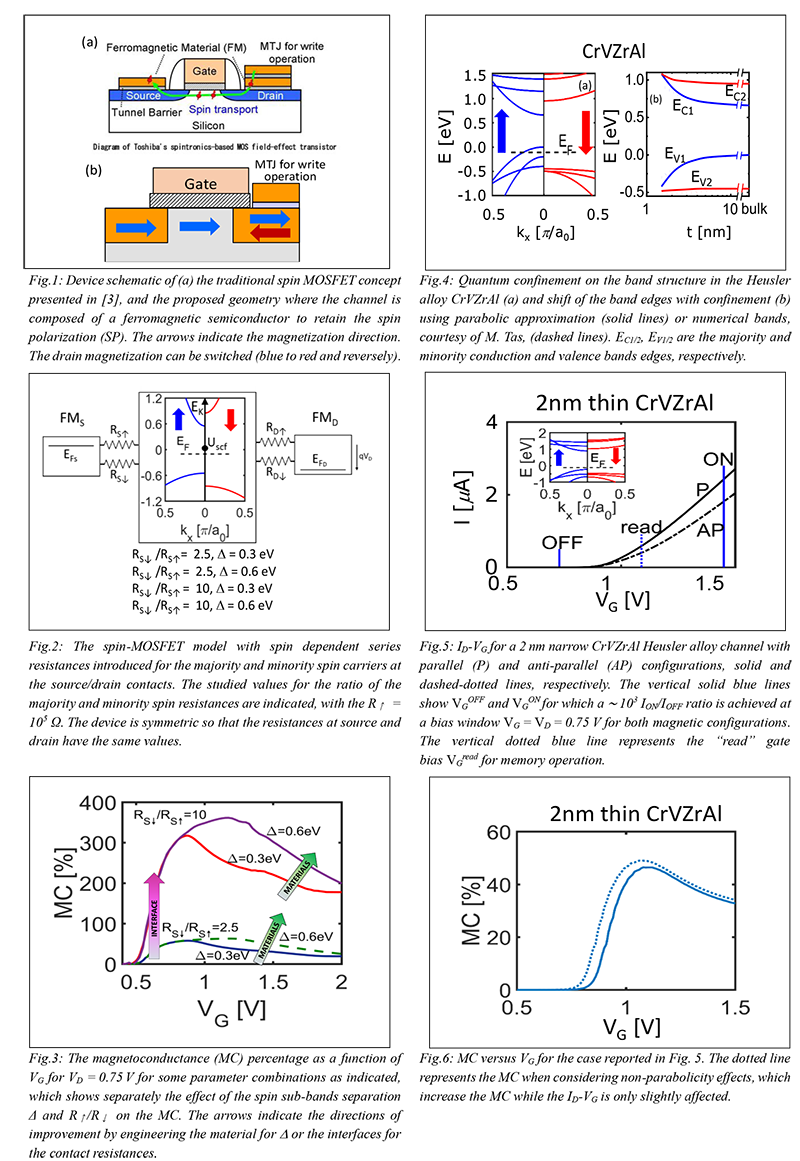IWCN 2021: Simulation of Ballistic Spin-MOSFET Devices with Ferromagnetic Channels
Category
Published on
Abstract
Newly emerged materials from the family of Heusler alloys and complex oxides exhibit finite bandgaps and ferromagnetic behavior with Curie temperatures much higher than room temperature. In this work, using the semiclassical top-of-the-barrier FET model [1], and a spin dependent contact resistance model derived from [2] (Fig. 2), we explore the operation of a spin-MOSFET that utilizes such ferromagnetic semiconductors as channel materials, in addition to ferromagnetic source/drain contacts (Fig. 1) [3]. Such a device could retain the spin polarization of injected electrons, the loss of which limits the operation of traditional spin transistors with non-ferromagnetic channels, such as Si-spin MOSFETs [4].
We examine the operation of four material systems that are currently considered as some of the most prominent known ferromagnetic semiconductors, three Heusler-type alloys (Mn2CoAl, CrVZrAl, CoVZrAl) and one from the oxide family (NiFe2O4) [5]. Importantly, a ferromagnetic semiconductor Heusler alloy has been recently verified [6]. We describe the band structures by using data from DFT calculations, but also consider the effect of 2D confinement in the bands. We investigate under which conditions high spin polarization and significant ION/IOFF ratio, two essential requirements for the spin-MOSFET operation, are both achieved. We show that these particular Heusler channels, in their bulk form, do not have adequate bandgap to provide high ION/IOFF ratios, and have small magneto-conductance compared to state-of-the-art devices (Fig. 3). However, with confinement into ultra-narrow sizes down to a few nanometers, and by engineering their spin dependent contact resistances, the proposed geometry can reach 103 ION/IOFF ratio and MR of tens of percentage units (Fig. 3-6). Thus, they could prove promising channel materials for the realization of spin-MOSFET transistor devices that offer combined logic and memory functionalities [3, 4]. Although the main compounds of interest in this paper are Mn2CoAl, CrVZrAl, CoVZrAl, and NiFe2O4 alone, we expect that the insight we provide is relevant to other classes of such materials as well.

Sponsored by
References
- A. Rahman et al., IEEE Trans. Electron Devices 50, 1853 (2003).
- T. Valet and A. Fert, Phys. Rev. B 48, 7099 (1993).
- T. Marukame et al., International Electron Devices Meeting (IEDM) 2009, pp. 1–4.
- M. Ishikawa et al., J. Magn. Soc. Jpn. 44, 56 (2020).
- P. Graziosi and N. Neophytou, J. Appl. Phys. 123, 084503 (2018).
- G. M. Stephen et al., J. Appl. Phys. 125, 123903 (2019).
Cite this work
Researchers should cite this work as follows: